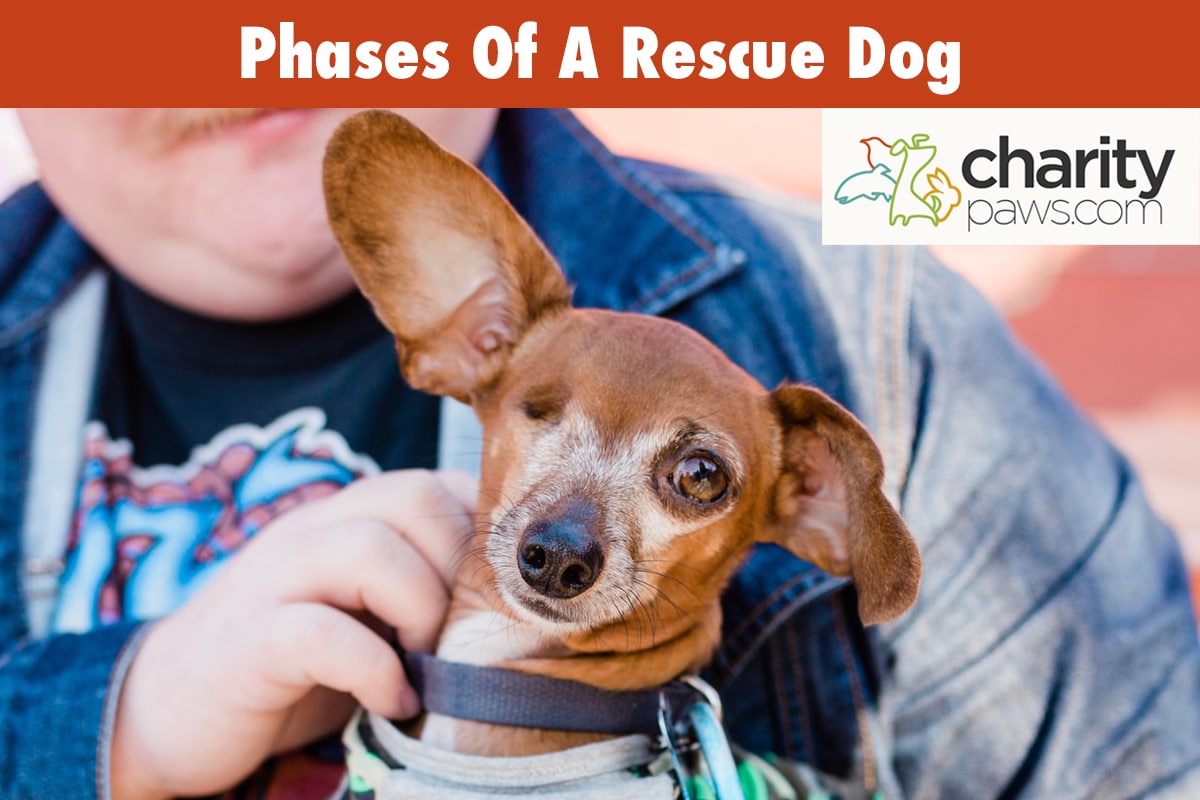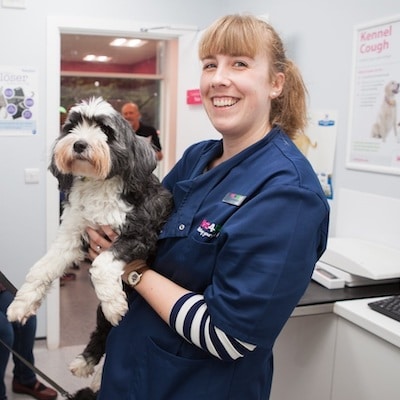Are you think about adopting a rescue dog?
Bringing home a new dog, especially a rescue dog can be an exiting time for you but maybe not so much for your new rescue.
When taking on a rescue dog it’s important to help them settle in as smoothly as possible.
There are some natural phases your dog will go through as he adjusts to his new home.
We will also look at some practical steps you can take to help your new furry friend adjust to living with you.

Overview Of The 3-3-3 Rule For Rescue Dogs
You might be wondering “How long does it take a rescue dog to adjust to its new home“?
Well, the 3-3-3 rule describes the first 3 days, 3 weeks, and 3 months of owning a new rescue dog, and it also helps us to understand the 3 different stages that these animals go through when settling in.
It’s important to understand that each dog is individual and will have had different life experiences before arriving at its forever home.
This means that they may proceed through the different phases at varying rates.
But as a guide, these are the stages that your pup will go through:
3 Days – The Introductory Period
This describes the period when you first bring your new dog into your home.
This is the time when your dog will first meet the various members of your household, and other pets and start to acclimate himself to his new surroundings.
Some dogs can find this time a bit stressful or overwhelming, particularly if they have been living in a kenneled environment for a while
Give your new pup some space to explore his surroundings in his own time.
Try and let them come to you and speak in reassuring and friendly tones.
3 Weeks – Settling In His New Home
During the first 3 weeks, your dog will start to feel a bit more comfortable.
They will become familiar with the daily routine and start to increase in confidence.
You may start to see your dog’s true personality emerging, though some dogs can still be subdued.
Stick to your daily routine and start implementing some training.
It’s important to be consistent during this time so that your dog knows what is expected of him.
3 Months – The Bonding Period
After about 3 months many dogs are feeling much more secure and they are feeling safe with you and your family.
Most dogs will have learned the daily routine and by making sure you have consistent rules to abide by, he will know where he stands.
Spend plenty of time doing fun things with your new rescue dog during this time to help him bond with you, such as walks, play, and grooming.
Adopting A Rescue Dog, The First Seven Days
As the 3-3-3 rule can be a bit variable, depending on your rescue dog’s personality, so some people find it easier to just focus on what to do during the first seven days.
Here are a few tips to help you and your dog work through that initial time together.
Curb Your Enthusiasm
Of course, it’s an exciting time welcoming a new family member into your home!
But try and keep this enthusiasm under control.
Your new rescue dog may be feeling a little stressed and overwhelmed, and over-the-top attention might not be welcomed.
Let him come to you in his own time and speak to him in low, soothing, friendly tones rather than squealing or talking in high-pitched baby voices.
Manage Introductions
Try and limit visitors in the early days as this can be unsettling for your new dog.
A busy house with lots of people coming and going is not ideal.
Similarly, introductions to family members and pets should be performed in a controlled manner.
Never leave children alone with your new dog, they behave unpredictably, and are usually loud and excitable, adding to your dog’s stress.
Even if your dog isn’t aggressive some dogs can nip out of fear or because they feel cornered.
Interactions with other pets will need similar supervision and it may be best to do these gradually, exposing your pets to each other for short periods initially before increasing the time they spend in each other’s company.
Don’t expect them to be best friends right away.
Establish A Daily Routine
From very early on you should have a routine in place for your new rescue dog, so that he knows what to expect from his day.
Feeding times should be consistent (some dogs may have issues around food if they have been previously neglected) as well as regular walks.
Understand His Training Requirements
By speaking with the rescue center, you can understand how much training he already has, including what command words he already responds to, so as not to confuse him.
Hopefully, they can also give you some idea as to any phobias he has or whether there are any guarding issues, for example, is he protective of toys or food?
This lets you know what to expect from your first week together as well as what you might need to start working on.
The Rescue Dog Honeymoon Period
As with any new relationship, there is often a honeymoon period.
This describes the time when everything is new and exciting, and things seem to be going smoothly.
You are both eager to please each other and are remaining guarded as you get to know one another.
You may even feel quite smug with how well your rescue dog has adjusted.
But as your dog settles into his new home and family, his stress hormones start to decrease, and his real personality starts to come through.
Sadly, in some cases, this may reveal behaviors that are less than ideal and may even be the reason why he entered the rescue system in the first place.
How long the honeymoon period lasts is again variable, but most rescue dog owners report this wearing off somewhere between one month and five.
This is also a similar thing as puppy blues.
The reason for this isn’t certain but it is thought your rescue dog suppresses his true nature when feeling stressed, appearing more subdued than normal.
Particularly as he may have had some negative experiences and interactions in the past.
As his confidence increases he may start to act more ‘normal’, perhaps becoming more vocal, chewing more, or becoming boisterous.
Another issue is that many owners feel sorry for their rescued pup and may be a bit lax on the rules in the early days.
Therefore it’s important to be consistent from day one.
Don’t expect your dog to suddenly sleep on the floor when you have allowed him on your bed during the first few weeks.
Lack of consistency can make it hard for some dogs to understand what the rules are, and this is where boundaries can get pushed.
Tackling The End Of The Honeymoon Period
To best deal with the end of the honeymoon period make sure you are consistent with your training.
Reinforce positive behaviors with praise, treats and play.
Make sure that all the family is on board with what the rules are, such as:
- Don’t encourage begging at the table
- He should not be allowed on the furniture
- He should not be allowed to dig in the garden
- Don’t allow him to chew on non-chew toys (shoes, socks, furniture).
Then stick with a consistent routine so that these behaviors are not reinforced.
If you are having difficulty with your pup’s antics, then speak to a qualified dog trainer sooner rather than later.
Don’t ignore the situation as behaviors are likely to continue or get worse without intervention.
How To Help Your Adopted Dog Adjust To A New Home
We have looked at some of the emotional considerations you will need to make when settling a rescue dog into your home.
Now let’s have a look at a few practical steps you can take to help your dog feel at home, ideally preparing as much of this in advance of your pup’s arrival as possible.
Dog Proof Your Home
Make sure valuable ornaments and possessions are all out of your dog’s reach, an enthusiastic waggy tail could easily knock things over or your new dog may have a chewing habit that you are not yet aware of.
Make sure food items and cleaning products are stored away safely.
Install stair gates if you want to keep your dog downstairs in a certain area of the house.
Also, ensure your yard is securely fenced and free from any dangerous debris that your new rescue dog could injure himself on.
Set Up His Own Bed Or Area
Your dog needs his own safe space that he can retreat to when things are feeling a bit too much.
This could be a cozy bed or basket, or even a crate.
It’s important that when your dog is in his bed area that he is not disturbed, this is his zone for some peace and quiet.
Small children are especially bad at invading a dog’s personal space, so make sure everyone is aware that his bed isn’t a play area, and he should be left to sleep when he wants.
Try Calming Or Appeasing Pheromones
The dog appeasing pheromone (Verified Source – NIH.gov) is something that mother dogs produce when feeding her puppies.
This triggers a calming response in puppies helping them feel secure.
You can purchase products to replicate this effect in adult dogs.
These are available as plug-in diffusers, sprays, or impregnated collars and could help your dog to settle in more effectively.
Register With A Veterinarian
Make sure your new rescue dog is registered with a vet as soon as possible in case you require veterinary treatments, especially in an emergency.
Ideally, you would also take your dog for a health check within a week or so of your pet’s arrival will help make sure you are on track with preventative treatments like worming and vaccinations.
It will also help identify any health issues that the rescue center might have missed.
Conclusion On Phases Of A Rescue Dog

It is perfectly normal for your rescue dog to go through phases when he is settling into your home.
The exact length that these phases will last depends on your dog’s personality and previous life experiences.
The phases of a rescue dog may be different with your new pup than what you are expecting.
To steer your way through, make sure you establish set rules and boundaries from the start and work on positive training to reinforce good behaviors.
Make sure you get advice from a qualified pet trainer if you are struggling, as it’s best to iron out any problems early on.

